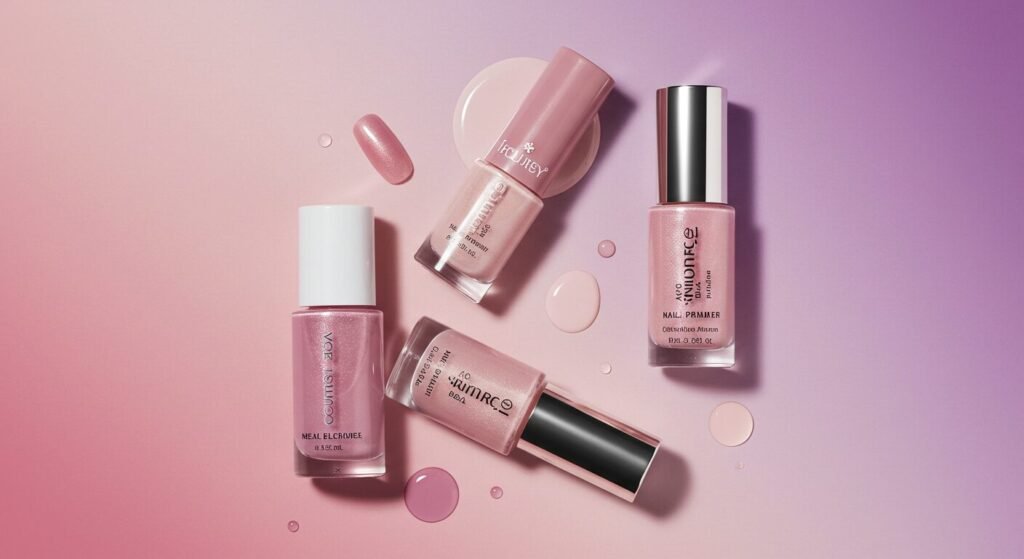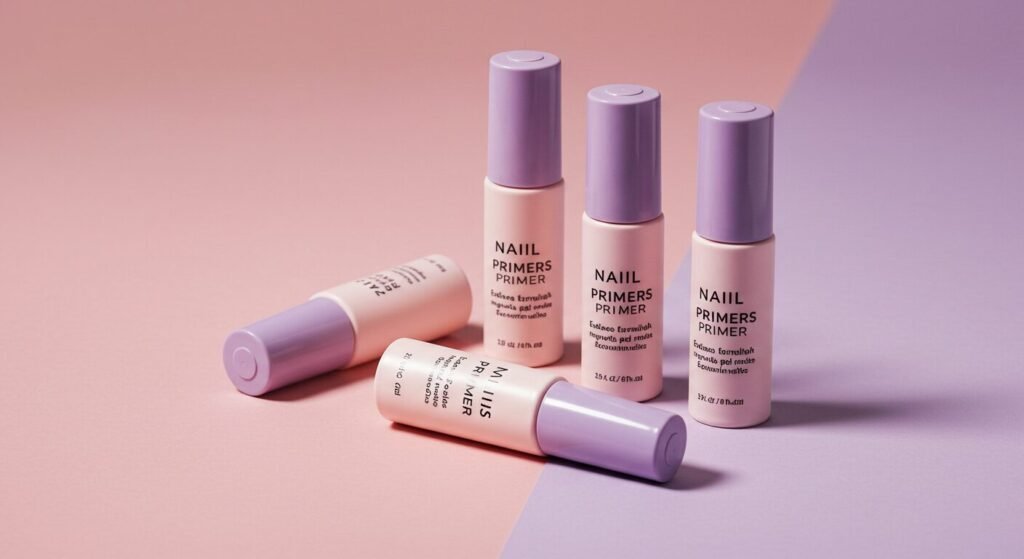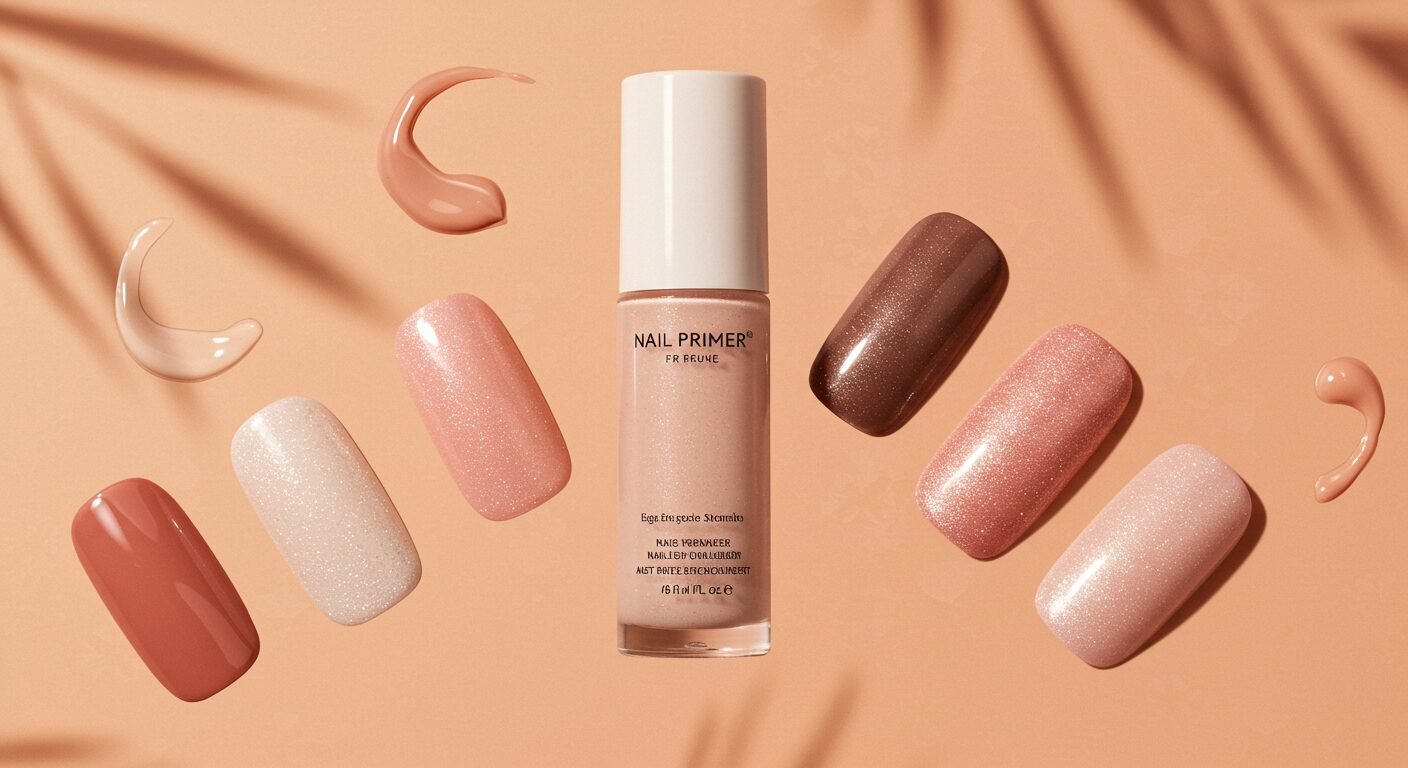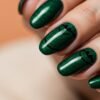Are you frustrated with nail polish that chips within days or gel manicures that lift prematurely? The secret to professional-quality, long-lasting nail applications lies in a crucial step that many people overlook – nail primer. This essential product creates the perfect foundation for flawless manicures that maintain their beauty for weeks instead of days.
Nail primer acts as the critical bridge between your natural nail surface and polish or enhancement products, creating optimal adhesion conditions while protecting your natural nails from potential damage. Unlike base coats that sit on top of nails, nail prep primer chemically prepares the nail surface for maximum bonding and extended wear time.
Whether you’re applying regular polish, gel manicures, or acrylic nails, understanding what is nail primer and how to use it correctly transforms your nail care results from disappointing to professional-quality. This comprehensive guide explores everything you need to know about selecting, applying, and maximizing the benefits of this game-changing nail care essential.
Understanding Nail Primer Basics
What Is Nail Primer?
Nail primer definition describes a specialized preparatory product that modifies natural nail surface characteristics to enhance adhesion of subsequent polish, gel, or enhancement products. Primer function involves removing surface oils, adjusting pH levels, and creating optimal bonding conditions.
Chemical composition varies among primer types but typically includes dehydrating agents, pH adjusters, and adhesion promoters that work together to prepare nail surfaces. Primer vs base coat distinctions are crucial – primers prepare the nail surface chemically while base coats provide physical protection and color barriers.
Professional necessity in salon environments makes primer essential for achieving the long-lasting, damage-free results that clients expect from professional nail services and applications.
How Nail Primer Works
Adhesion enhancement occurs through multiple mechanisms including surface dehydration, pH modification, and molecular bonding that create strong connections between natural nails and applied products.
Surface preparation removes oils, moisture, and contaminants that interfere with product adhesion while creating microscopically roughened surfaces that enhance mechanical bonding between layers.
Chemical bonding in acid-based primers creates molecular connections between nail keratin and enhancement products, providing superior adhesion compared to mechanical bonding alone through surface preparation.
Types of Nail Primers
Acid-Based Primers
Acid nail primer uses methacrylic acid or similar compounds to etch nail surfaces, creating superior adhesion for acrylic and gel applications. Acid primer benefits include exceptional bonding strength and extended wear time for enhancement products.
Professional use of acid primers requires careful application technique and safety precautions due to the caustic nature of acidic compounds that can cause burns if mishandled or over-applied.
Suitability considerations make acid primers ideal for challenging nail conditions including oily nails, clients with lifting problems, or situations requiring maximum adhesion strength for demanding applications.
Non-Acid Primers
Acid-free nail primer provides gentler adhesion enhancement without harsh etching agents, making them suitable for sensitive individuals and less challenging nail conditions. Non-acid formula benefits include improved safety and reduced damage risk.
Bonding mechanisms in non-acid primers rely on dehydration and molecular attraction rather than chemical etching, providing good adhesion with less aggressive nail surface modification.
Versatility advantages make non-acid primers appropriate for various enhancement types and natural nail conditions while maintaining safety profiles suitable for home use and sensitive clients.
Dehydrators vs Primers
Nail dehydrator removes surface moisture and oils without chemical bonding action, serving as preliminary preparation step before primer application. Dehydrator function creates dry surfaces optimal for primer and product adhesion.
Usage sequence typically involves dehydrator application first, followed by primer, then enhancement products in systematic preparation protocols that maximize adhesion and longevity.
Product confusion between dehydrators and primers leads many people to skip necessary steps or use products incorrectly, compromising results and potentially causing nail damage or premature product failure.
Gel Nail Primer Applications

Gel Polish Primer
Gel nail primer specifically formulated for gel polish systems creates optimal adhesion while preventing common problems like peeling and lifting that plague gel manicures. Gel-specific formulations address unique bonding requirements of UV-cured products.
Application techniques for gel primers differ slightly from traditional primers, with specific timing requirements and curing considerations that affect final results and manicure longevity.
Compatibility issues between different gel systems and primers require attention to manufacturer recommendations and testing to ensure optimal results without adverse reactions or adhesion failures.
LED and UV Considerations
Curing requirements for gel primers vary by formulation, with some requiring light exposure while others air-dry before gel polish application. Light compatibility ensures primers work correctly with available curing equipment.
Professional equipment including proper LED or UV lamps ensures complete curing and optimal bonding for gel primer and polish systems. Home equipment may require longer curing times or specific primer formulations.
Safety considerations for gel primers include proper ventilation, skin protection, and following manufacturer guidelines for curing times and application procedures to prevent skin sensitivity or product failure.
Acrylic Nail Primer

Acrylic Enhancement Preparation
Acrylic nail primer creates essential bonding foundation for liquid and powder systems, preventing lifting and ensuring long-lasting enhancement wear. Acrylic-specific formulations address unique adhesion requirements of acrylic chemistry.
Application protocols for acrylic primers require precise technique including thin, even coverage and proper drying time before monomer application to prevent interference with acrylic polymerization.
Professional standards in acrylic application mandate proper primer use as essential step in preventing service breakdown, client dissatisfaction, and potential nail damage from premature lifting.
Methacrylic Acid Primers
Professional-grade primers containing methacrylic acid provide strongest adhesion for challenging nail conditions but require careful handling and expert application technique to prevent damage.
Safety protocols for acid primers include avoiding skin contact, proper ventilation, and careful application only to nail plates while protecting surrounding skin from caustic compounds.
Alternatives considerations balance adhesion strength needs with safety concerns, client sensitivity, and nail health priorities when selecting appropriate primers for specific situations and client conditions.
Application Techniques and Best Practices
Proper Application Steps
Nail preparation begins with thorough cleaning, shaping, and cuticle care before any primer application to ensure optimal surface conditions. Surface preparation includes gentle buffing to remove shine without damaging nail plates.
Primer application technique involves thin, even coverage using small amounts of product applied carefully to avoid skin contact and pooling in cuticle areas. Drying time must be complete before proceeding to next application steps.
Common mistakes include over-application, insufficient drying time, and application to skin or cuticles that can cause irritation, burning, or adhesion problems that compromise final results.
Timing and Sequencing
Product layering sequence follows specific order: nail preparation, dehydrator (if used), primer, base coat or enhancement products in systematic protocol that maximizes each product’s effectiveness.
Wait times between steps ensure each product performs its intended function before next application, with rushing compromising adhesion and longevity of final results.
Professional protocols include specific timing guidelines that optimize results while maintaining efficient service delivery in salon environments where time management affects profitability and client satisfaction.
Nail Primer for Different Enhancement Types

Natural Nail Polish Application
Polish primer benefits include extended wear time, reduced chipping, and smoother application surfaces for regular nail polish manicures. Natural nail considerations require gentler formulations that protect nail health.
Home manicure enhancement through proper primer use elevates results from amateur to professional quality without requiring salon visits or expensive professional services.
Compatibility concerns with different polish brands and formulations require testing and attention to manufacturer recommendations for optimal adhesion and wear performance.
Dip Powder Systems
Dip powder primer creates optimal bonding surface for powder adhesion and resin penetration that characterize dip manicure systems. System-specific requirements vary among different dip powder brands and formulations.
Application modifications for dip systems include specific primer types and application techniques that differ from gel or acrylic preparation protocols.
Longevity enhancement through proper primer use significantly extends dip manicure wear time while reducing common problems like lifting and premature breakdown.
Safety and Health Considerations
Chemical Safety
Ingredient awareness includes understanding potentially harmful compounds in primers and selecting products appropriate for personal health status and sensitivity levels. Toxic chemical concerns affect product selection and usage decisions.
Ventilation requirements during primer application prevent inhalation of fumes that can cause respiratory irritation or sensitization with repeated exposure over time.
Skin protection protocols prevent contact between primers and skin, particularly acid formulations that can cause chemical burns or severe irritation with direct contact or prolonged exposure.
Allergy and Sensitivity
Allergic reactions to primer ingredients can develop over time with repeated exposure, requiring product changes or discontinuation of primer use in affected individuals.
Patch testing before regular use helps identify potential sensitivities before applying products over large areas or committing to regular use in professional or personal nail care routines.
Alternative options for sensitive individuals include gentler formulations, non-acid primers, or natural preparation methods that provide some adhesion benefits without harsh chemical exposure.
Professional vs DIY Primer Use
Salon Application Standards
Professional protocols ensure proper primer selection, application technique, and safety compliance that protects client health while delivering optimal manicure results and service longevity.
Technician training includes proper primer usage as fundamental skill necessary for professional certification and successful salon service delivery across various enhancement types.
Quality control in professional settings involves monitoring primer effectiveness, client reactions, and service longevity to maintain consistent quality and customer satisfaction standards.
Home Use Considerations
DIY primer application requires careful product selection, technique learning, and safety awareness to achieve professional results without professional supervision or training.
Skill development for home primer use involves practice, education through tutorials and guides, and gradual technique improvement through experience and observation of results.
Product selection for home use should prioritize safety, ease of application, and appropriate strength for intended enhancement types while considering personal skill level and experience.
Product Selection Guidelines
Choosing the Right Primer
Nail condition assessment guides primer selection based on natural nail characteristics including oiliness, flexibility, and previous enhancement experiences that indicate adhesion needs.
Enhancement type matching ensures primer selection appropriate for specific nail products being applied, whether gel polish, acrylics, or dip powders with varying adhesion requirements.
Brand compatibility considerations include manufacturer recommendations and testing to ensure products work well together without adverse reactions or reduced effectiveness.
Quality Indicators
Ingredient transparency from reputable manufacturers allows informed decision-making about product safety and effectiveness for specific applications and personal health considerations.
Professional endorsements and salon usage patterns provide insights into primer effectiveness and reliability for various enhancement types and nail conditions.
Price-quality balance helps identify value options that provide necessary performance without unnecessary premium pricing for features or branding that don’t enhance results.
Common Problems and Solutions
Lifting and Adhesion Failures
Lifting causes include improper primer application, contaminated nail surfaces, or incompatible product combinations that prevent proper bonding between nail and enhancement products.
Prevention strategies involve proper nail preparation, correct primer selection and application, and following complete preparation protocols that ensure optimal adhesion conditions.
Troubleshooting approaches help identify specific causes of adhesion problems through systematic evaluation of preparation steps, product selection, and application techniques used.
Overuse and Damage
Over-priming effects can include nail plate softening, excessive brittleness, or sensitivity that results from too-frequent application or excessive product amounts during application.
Damage prevention requires understanding proper primer amounts, application frequency limitations, and recognizing when nail health requires breaks from enhancement products and preparations.
Recovery protocols for over-primed or damaged nails include rest periods, moisturizing treatments, and strengthening regimens that restore nail health before resuming enhancement applications.
Natural and Alternative Options
Gentler Primer Alternatives
Natural nail primers using less aggressive formulations provide some adhesion benefits while minimizing chemical exposure and potential damage to natural nail health.
Oil-based preparations can serve as gentle surface treatments that improve polish adhesion slightly without harsh dehydration or chemical modification of nail surfaces.
Buffing techniques provide mechanical surface preparation that enhances adhesion through physical texture without chemical treatments that may concern some users.
DIY Primer Recipes
Homemade primers using simple ingredients like rubbing alcohol or white vinegar provide basic dehydration and cleaning benefits, though effectiveness is limited compared to commercial products.
Natural alternatives appeal to individuals seeking chemical-free nail care options, though adhesion enhancement and wear time improvements may be modest compared to commercial primers.
Effectiveness limitations of DIY primers should be understood, with realistic expectations about performance compared to professionally formulated products designed specifically for nail adhesion enhancement.
Professional Brands and Market Leaders
Premium Primer Brands
Professional product lines from established manufacturers like CND, OPI, and Young Nails offer proven formulations backed by professional use and salon testing.
Innovation leaders continually improve primer formulations through research into new bonding technologies, safer ingredients, and enhanced performance characteristics.
Specialty brands focus specifically on primers and preparation products, offering deep expertise and specialized formulations for various nail types and enhancement systems.
Budget-Friendly Options
Affordable primers provide basic functionality at accessible price points, though performance and safety profiles may vary compared to premium professional formulations.
Value assessment considers cost per application, effectiveness for intended use, and safety profiles when evaluating budget options against premium alternatives.
Quality compromises in budget primers may include less effective adhesion, shorter wear time, or safety concerns that should be weighed against cost savings.
Industry Trends and Innovations
Emerging Technologies
Advanced bonding systems incorporate new chemistry and delivery mechanisms that enhance adhesion while improving safety and reducing nail damage from preparation processes.
Nano-technology applications in primers may improve penetration and bonding efficiency while reducing amounts needed for effective results and potentially enhancing safety profiles.
Smart formulations adapt to individual nail conditions or environmental factors, providing customized preparation that optimizes results for varying circumstances and nail types.
Sustainability Developments
Eco-friendly primers address environmental concerns through biodegradable ingredients, sustainable sourcing, and reduced chemical impacts without sacrificing adhesion performance.
Clean beauty movement influences primer formulations with emphasis on transparency, natural ingredients, and elimination of controversial compounds from product compositions.
Packaging innovations reduce waste and environmental impact while maintaining product integrity and safety throughout shelf life and consumer use periods.
Education and Training
Professional Education
Technician training programs include comprehensive primer education covering chemistry, application techniques, safety protocols, and troubleshooting for professional certification requirements.
Continuing education keeps professionals updated on new primer technologies, evolving best practices, and emerging research regarding nail health and product safety.
Skill certification in various enhancement systems includes proper primer use as fundamental competency necessary for professional practice and quality service delivery.
Consumer Education
Product knowledge helps consumers make informed decisions about primer selection and usage for home manicure applications that achieve professional-quality results.
Technique tutorials through videos, articles, and demonstrations teach proper application methods that maximize primer effectiveness while ensuring safety and nail health.
Safety awareness education protects consumers from potential hazards through proper handling, storage, and application of primer products containing active chemical compounds.
Regulatory and Safety Standards
Industry Regulations
FDA oversight of cosmetic products includes primers, though regulatory framework differs from drugs with varying requirements for safety testing and ingredient disclosure.
International standards vary among countries affecting product availability, formulation requirements, and safety testing necessary for different markets and regulatory environments.
Professional licensing requirements may include primer safety training and proper usage protocols as part of mandatory education for nail technicians and salon professionals.
Safety Compliance
Ingredient restrictions in various jurisdictions limit or prohibit certain primer components based on safety concerns or environmental impacts that affect product formulation and availability.
Labeling requirements ensure consumers and professionals receive necessary safety information, usage instructions, and warnings about potential hazards associated with primer products.
Workplace safety standards in salons mandate proper ventilation, storage, and handling procedures for primers and other nail care chemicals that present potential health hazards.
Economic Considerations
Cost-Benefit Analysis
Investment value of quality primers includes extended manicure longevity, reduced product waste, and fewer service breakdowns that justify higher initial costs through long-term savings.
Salon economics involve primer costs as essential business expense that affects service quality, client retention, and overall profitability through proper product selection and usage.
Home use considerations balance primer costs against salon visit expenses, product waste reduction, and enhanced satisfaction with home manicure results that meet personal quality expectations.
Market Pricing
Price ranges for primers vary significantly from budget drugstore options to premium professional formulations, with performance differences justifying price variations.
Value indicators help identify optimal price points that balance cost with performance, safety, and suitability for specific enhancement types and application frequency.
Bulk purchasing options for frequent users or professionals reduce per-application costs while ensuring adequate supply availability for consistent application and optimal results.
Storage and Shelf Life
Proper Storage Methods
Storage conditions affect primer longevity and effectiveness, with cool, dry locations away from direct sunlight maintaining optimal product characteristics throughout shelf life.
Container integrity preservation through proper sealing prevents evaporation and contamination that degrade primer quality and effectiveness over time.
Temperature control protects primers from extreme heat or cold that can alter chemical composition and reduce effectiveness or create safety hazards through chemical changes.
**Expiration and Quality
Shelf life varies among primer types with acid-based formulations generally remaining stable longer than some non-acid alternatives that may degrade more quickly.
Quality indicators help identify primers that have degraded or expired through changes in consistency, color, odor, or effectiveness that suggest replacement is necessary.
Usage patterns affect practical shelf life with frequent users depleting products before expiration while occasional users must monitor product condition for degradation signs.
Future Outlook
Research Directions
Scientific studies exploring nail adhesion mechanisms inform primer development and optimization for enhanced effectiveness with reduced health and environmental impacts.
Technology advances in delivery systems, bonding chemistry, and safety improvements continue evolving primer formulations and application methods for better results.
Health research investigates long-term effects of primer ingredients and usage patterns, informing safety guidelines and product development priorities for manufacturers.
Market Evolution
Consumer demands for cleaner, safer, and more effective primers drive product development and market offerings that balance performance with health and environmental concerns.
Professional preferences influence product development through feedback on effectiveness, safety, and ease of use that manufacturers incorporate into formula improvements.
Regulatory changes may affect primer formulations, availability, and usage guidelines as safety research and environmental concerns evolve within regulatory frameworks.
Conclusion
Nail primer represents the critical foundation for professional-quality manicures that last, whether you’re applying regular polish, gel color, or acrylic enhancements. Understanding what nail primer is, how it works, and proper application techniques transforms your nail care results from disappointing to exceptional through this essential but often overlooked step.
The investment in quality nail primer pays dividends through extended manicure longevity, reduced chipping and lifting, and protection for your natural nails during enhancement wear. Whether you choose acid-based primers for maximum adhesion or gentler non-acid formulas for safety, proper selection and application are key to achieving the results you desire.
Professional nail technicians rely on primers as fundamental tools for delivering the long-lasting, beautiful results clients expect. Home users can achieve similar quality by understanding primer basics, selecting appropriate products for their enhancement type, and following proper application protocols that mirror professional standards.
Safety considerations remain paramount when using nail primers, particularly acid-based formulations that require careful handling and application technique. Following manufacturer guidelines, maintaining proper ventilation, and protecting skin from contact ensures safe use while maximizing the adhesion benefits primers provide.
Remember that nail primer is just one component of comprehensive nail care. Combining proper primer use with good nail health practices, quality products, and correct application techniques for your chosen enhancement type creates the complete system necessary for beautiful, long-lasting nails that enhance your overall appearance and confidence.
Frequently Asked Questions
What is the difference between nail primer and base coat?
Nail primer chemically prepares the nail surface by removing oils, adjusting pH, and creating optimal bonding conditions before polish application. Base coat is applied after primer and provides a protective barrier between natural nails and colored polish while creating smooth application surfaces. Primer is a preparation step while base coat is part of the actual polish system. Never skip primer when recommended, as base coat cannot provide the same adhesion enhancement and surface preparation that primers deliver.
Do I need to use nail primer with regular nail polish?
For regular nail polish, primer is optional but beneficial for extending wear time and preventing chipping, especially for oily nails or individuals whose polish chips quickly. Gel polish, acrylics, and dip powder systems require primer for proper adhesion and longevity. If you’re satisfied with your regular polish wear time, primer may be unnecessary. However, if you experience frequent chipping or short wear time, adding primer to your routine can significantly improve results without requiring professional services.
Can nail primer damage natural nails?
When used correctly and in moderation, nail primer should not damage natural nails. However, over-application, too-frequent use, or improper application can cause dehydration, brittleness, or weakening. Acid-based primers require particular caution as they chemically etch nail surfaces and can cause burns if misapplied to skin. Following product instructions, avoiding over-use, and allowing nails to rest between enhancement applications prevents damage while maintaining healthy nails. If you notice increasing nail damage, consult a professional about proper primer use.
How long does nail primer take to dry before applying polish or gel?
Drying time varies by primer type, typically ranging from 30 seconds to 2 minutes. Most primers appear wet initially then dry to a chalky or matte finish, indicating readiness for next steps. Never apply polish or enhancements over wet primer as this compromises adhesion and longevity. Read product instructions for specific timing as some primers require air drying while others may need brief LED/UV curing. Rushing this step is a common mistake that significantly reduces manicure longevity.
Is acid-free primer as effective as acid-based primer?
Acid-free primers provide good adhesion for most normal nail conditions and are safer with reduced risk of damage or burns. However, acid-based primers offer superior bonding strength for challenging situations like very oily nails, problematic lifting, or maximum longevity needs. For most home users and standard applications, acid-free primers provide sufficient adhesion with better safety profiles. Professional applications or difficult nail conditions may warrant acid-based primers under proper supervision and application technique to achieve necessary adhesion strength.
READ ALSO: Nail Growth Serum: 2025 Complete Guide to Faster, Stronger, and Healthier Nails
Was this helpful?
Your feedback helps us create better content
Thank you for your feedback!
Your input helps us improve our content.




